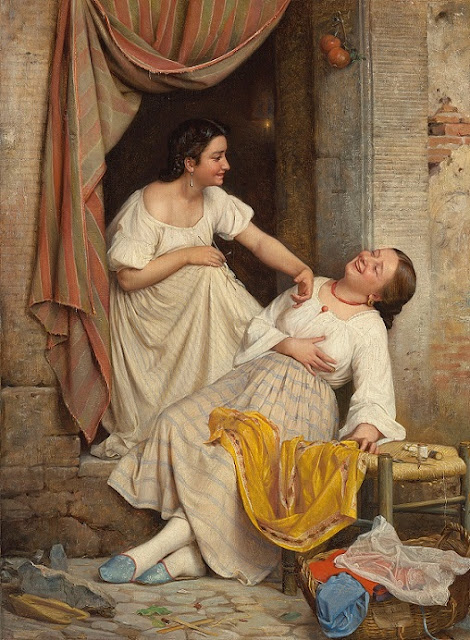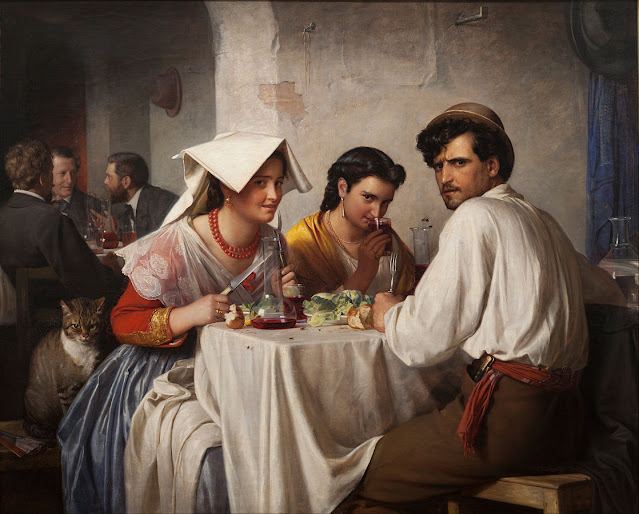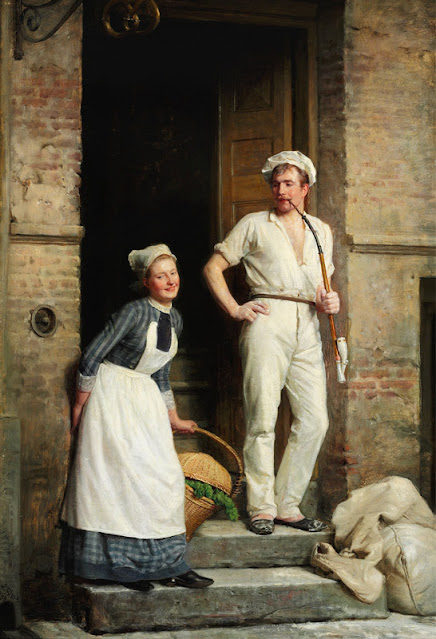Carlo Dolci, FLORENCE 1616 - 1687
The Penitent Magdalene
Oil on copper
20.3 x 26 cm.; 8 x 10 1/4 in
Private collection
In this intimate copper, destined for private devotion, we find the Magdalene repenting in the wilderness, her alluring nakedness reminding us of her unchaste past. Her breasts are exposed and the blue folds of her robes reveal her leg up to the thigh in a scene that, for all its allusion to the vanity of life and repentance, must, surely, have also been a celebration of the female form. More on this painting
Carlo (or Carlino) Dolci (25 May 1616 – 17 January 1686) was an Italian painter of the Baroque period, active mainly in Florence, known for highly finished religious pictures, often repeated in many versions.
As a boy and throughout his life, he was called “Carlino” (little Carlo), possibly because of his short stature and humble character. He was also extremely pious. If not diligently practicing drawing or developing his painter’s craft, he often could be found praying in Santa Maria Novella.
Carlo Dolci (1616–1686)
Saint Catherine of Siena, c. 1665
Oil on cedar panel
H 24.4 x W 18.1 cm
Dulwich Picture Gallery
Saint Catherine of Siena, T.O.S.D. (March 25, 1347 in Siena – April 29, 1380 in Rome), was a tertiary of the Dominican Order and a Scholastic philosopher and theologian. She also worked to bring the papacy of Gregory XI back to Rome from its displacement in France and to establish peace among the Italian city-states. Since 18 June 1939, she is one of the two patron saints of Italy, together with St. Francis of Assisi. On 3 October 1970, she was proclaimed a Doctor of the Church by Pope Paul VI, and on 1 October 1999, Pope John Paul II named her as one of the six patron saints of Europe, together with Benedict of Nursia, Saints Cyril and Methodius, Bridget of Sweden and Edith Stein. More on Saint Catherine of Siena
Although he was precocious and apprenticed at a young age to Jacopo Vignali, Dolci was not prolific. "He would take weeks over a single foot", according to his biographer Baldinucci. His painstaking technique made him unsuited for large-scale fresco painting.
Studio of Carlo Dolci, FLORENCE 1616 - 1687
The martyrdom of Saint Andrew
Oil on canvas,
122 by 99.5 cm.; 48 by 39 in.
Most references to Andrew in the New Testament simply include him on a list of the Twelve Apostles, or group him with his brother, Simon Peter. But he appears acting as an individual three times in the Gospel of John. When a number of Greeks wish to speak with Jesus, before Jesus feeds the Five Thousand, and the first two disciples whom John reports as attaching themselves to Jesus. Having met Jesus, Andrew then finds his brother Simon and brings him to Jesus. Thus, on each occasion when he is mentioned as an individual, it is because he is instrumental in bringing others to meet the Saviour. In the Episcopal Church, the Fellowship of Saint Andrew is devoted to encouraging personal evangelism, and the bringing of one's friends and colleagues to a knowledge of the Gospel of Christ.
Andrew is said to have been martyred by crucifixion at the city of Patras in Achaea, in AD 60. Early texts describe Andrew as bound, not nailed, to a Latin cross of the kind on which Jesus is said to have been crucified; yet a tradition developed that Andrew had been crucified on a cross of the form called crux decussata, now commonly known as a "Saint Andrew's Cross" — supposedly at his own request, as he deemed himself unworthy to be crucified on the same type of cross as Jesus had been. The iconography of the martyrdom of Andrew — showing him bound to an X-shaped cross — does not appear to have been standardized until the later Middle Ages. More on Saint Andrew
In 1632, when he was 16, Dolci opened his own workshop in Florence. One of his pupils was Filippo Baldinucci, who would become the leading connoisseur in Florence, and the author of the official biography of his “beloved Carlino.”
Carlo Dolci (1616–1686)
St Catherine Reading a Book, c. first half of 17th century
Oil on canvas
Residenzgalerie Salzburg
Saint Catherine of Alexandria is, according to tradition, a Christian saint and virgin, who was martyred in the early 4th century at the hands of the pagan emperor Maxentius. According to her hagiography, she was both a princess and a noted scholar, who became a Christian around the age of fourteen, and converted hundreds of people to Christianity. She was martyred around the age of 18. Over 1,100 years following her martyrdom, St. Joan of Arc identified Catherine as one of the Saints who appeared to her and counselled her.
The emperor condemned Catherine to death on a spiked breaking wheel, but, at her touch, it shattered. Maxentius ordered her to be beheaded. Catherine herself ordered the execution to commence. A milk-like substance rather than blood flowed from her neck.
The Eastern Orthodox Church venerates her as a Great Martyr, and celebrates her feast day on 24 or 25 November (depending on the local tradition). In the Catholic Church she is traditionally revered as one of the Fourteen Holy Helpers. In 1969 the Catholic Church removed her feast day from the General Roman Calendar; however, she continued to be commemorated in the Roman Martyrology on 25 November. More on Saint Catherine of Alexandria
He painted chiefly sacred subjects, and his works are generally small in scale, although he made a few life-size pictures. He often repeated the same composition in several versions, and his daughter, Agnese Dolci, also made excellent copies of his works.
Dolci gives us an opportunity to study his painstaking application of paint using ultrafine brushes, and only a few bristles, or the concentration it took to make tiny details look so real, as in the lace on the cloth beneath the Christ child’s feet in the foreground of The Virgin and Child with Lilies from Montpellier (See below).
After Carlo Dolci, 1616 - 1686
The Virgin and Child with Flowers, c. after 1642
Oil on canvas
78.1 x 63.2 cm
The National Gallery, London
The Virgin Mary holds a branch of lilies entwined with carnations in her left hand and supports the Christ Child with her right. He raises one hand in blessing, and holds a rose in the other. The rose and lily are commonly associated with the Virgin’s purity. More flowers lie in a basket. The golden-haired infant has a faint halo, making his head stand out against the dark background.
The tender atmosphere and delicacy of execution are typical of Carlo Dolci, who painted several versions of this scene for aristocratic patrons between 1642 and 1649 (there are examples in the Musée Fabre, Montpellier, and the Bayerische Staatsgemäldesammlungen, Munich). The refined draughtmanship, noticeable in details like the lace and the transparent veil covering Christ, is characteristic of the paintings he produced in the 1640s, although this version may be later and seems not to be by Dolci’s hand. More on this painting
Dolci, Carlo (Florence, 1616 - Florence, 1686)
The Virgin of the Annunciation, c. circa 1653 - 1655
Oil on canvas
Height: 0.52 m; Width: 0.4 m;
Louvre Museum
The Annunciation is the Christian celebration of the announcement by the angel Gabriel to the Virgin Mary that she would conceive and become the mother of Jesus, the Son of God, marking his Incarnation. Gabriel told Mary to name her son Yehoshua , meaning "YHWH is salvation".
According to Luke 1:26, the Annunciation occurred "in the sixth month" of Elizabeth's pregnancy. Many Christians observe this event with the Feast of the Annunciation on 25 March, an approximation of the northern vernal equinox nine full months before Christmas, the ceremonial birthday of Jesus. In England, this came to be known as Lady Day. It marked the new year until 1752. The 2nd-century writer Irenaeus of Lyon regarded the conception of Jesus as 25 March coinciding with the Passion. More The Annunciation
After Carlo Dolci (Italian, 1616–1686)
Saint Cecilie playing the piano
Oil on Canvas
96 x 80 cm. (37.8 x 31.5 in.)
Private collection
Saint Cecilia is a Roman martyr venerated in Catholic, Orthodox, Anglican and some Lutheran churches. She became the patron of music and musicians, it being written that, as the musicians played at her wedding, Cecilia "sang in her heart to the Lord"
According to the story, despite her vow of virginity, she was forced by her parents to marry a pagan nobleman named Valerian. During the wedding, Cecilia sat apart singing to God in her heart. When the time came for her marriage to be consummated, Cecilia told Valerian that watching over her was an angel of the Lord, who would punish him if he sexually violated her but would love him if he respected her virginity. When Valerian asked to see the angel, Cecilia replied that he could if he would go to the third milestone on the Via Appia and be baptized by Pope Urban I. After following Cecilia's advice, he saw the angel standing beside her, crowning her with a chaplet of roses and lilies.
The martyrdom of Cecilia is said to have followed that of her husband Valerian and his brother at the hands of the prefect Turcius Almachius. The legend about Cecilia's death says that after being struck three times on the neck with a sword, she lived for three days, and asked the pope to convert her home into a church. More on Saint Cecilia
After Carlo Dolci (1616–1686)
Saint Apollonia, patroness of dentists, c. 17th century
Oil on canvas
Height: 69 cm (27.1 in); Width: 60 cm (23.6 in)
Private collection
Saint Apollonia was one of a group of virgin martyrs who suffered in Alexandria during a local uprising against the Christians prior to the persecution of Decius. According to legend, her torture included having all of her teeth violently pulled out or shattered. For this reason, she is popularly regarded as the patroness of dentistry and those suffering from toothache or other dental problems.
Baldinucci tells us that rather early in his career Dolci vowed to paint only religious works. A handful of portraits have survived, however, including the Portrait of Stefano della Bella, which demonstrates Dolci’s skill in capturing the sitter’s personality as well as every fold and ruffled edge of the multi-layered linen.
Carlo Dolci (1616–1686)
The Angel of the Annunciation, c. 17th century
Oil on canvas Edit this at Wikidata
Height: 52.5 cm (20.6 in); Width: 40 cm (15.7 in)
Louvre Museum
In the Bible, the Annunciation is narrated in Luke 1:26-38:
26 And in the sixth month, the angel Gabriel was sent from God into a city of Galilee, called Nazareth,27 To a virgin espoused to a man whose name was Joseph, of the house of David; and the virgin's name was Mary.28 And the angel being come in, said unto her: Hail, full of grace, the Lord is with thee: blessed art thou among women.
29 Who having heard, was troubled at his saying, and thought with herself what manner of salutation this should be.30 And the angel said to her: Fear not, Mary, for thou hast found grace with God.31 Behold thou shalt conceive in thy womb, and shalt bring forth a son; and thou shalt call his name Jesus.32 He shall be great, and shall be called the Son of the most High; and the Lord God shall give unto him the throne of David his father; and he shall reign in the house of Jacob for ever.33 And of his kingdom there shall be no end. More on The Angel of the Annunciation
Dolci was known for his piety. It is said that every year during Passion Week he painted a half-figure of the Savior wearing the Crown of Thorns. In 1682, when he saw Giordano, nicknamed "fa presto" (quick worker), paint more in five hours than he could have completed in months, he fell into a depression.
Carlo Dolci (1616–1686)
The Guardian Angel, c. 1675
Oil on canvas
Museo dell'Opera del Duomo
Dolci's daughter, Agnese (died circa 1680), was also a painter. Dolci died in Florence in 1686.
CARLO DOLCI (FLORENCE 1616-86)
Salome with the Head of John the Baptist, c.1665-70
Oil on canvas
126.0 x 102.0 cm
King's Drawing Room, Kensington Palace
Salome was the daughter of Herod II and Herodias. She is infamous for demanding and receiving the head of John the Baptist, according to the New Testament. According to Flavius Josephus's Jewish Antiquities, Salome was first married to Philip the Tetrarch of Ituraea and Trakonitis. After Philip's death in 34 AD she married Aristobulus of Chalcis and became queen of Chalcis and Armenia Minor. They had three children. Three coins with portraits of Aristobulus and Salome have been found. Her name in Hebrew meaning "peace". More on Salome
According to Baldinucci, Dolci painted three versions of this subject, the first for Marchese Pier Francesco Rinuccini and the second 'for John Finch, Resident in Florence for His Majesty the King of England, to whom the Resident gave it, and it was placed in the King's own bedroom'. The Royal Collection painting can be confidently identified as Dolci's second version of the subject. Unfortunately the Rinuccini version was last heard of in 1870, and its whereabouts remain unknown. More on this painting
Please visit my other blogs: Art
Collector, Mythology, Marine
Art, Portrait of a Lady, The
Orientalist, Art of the Nude and The
Canals of Venice, Middle
East Artists, 365
Saints and 365 Days, also visit my Boards on Pinterest
Images are copyright of their respective owners, assignees or others.
Some Images may be subject to copyright
I don't own any of these images - credit is always given when due unless
it is unknown to me. if I post your images without your permission, please tell
me.
I do not sell art, art prints, framed posters or reproductions. Ads are
shown only to compensate the hosting expenses.
If you enjoyed this post, please share with friends and family.
Thank you for visiting my blog and also for liking its posts and pages.
Please note that the content of this post primarily consists of articles
available from Wikipedia or other free sources online.















































